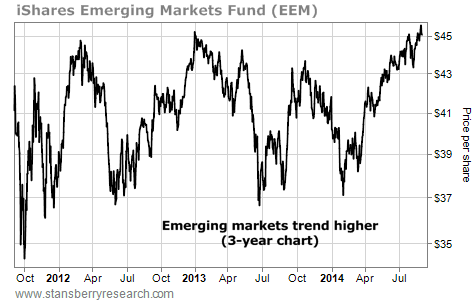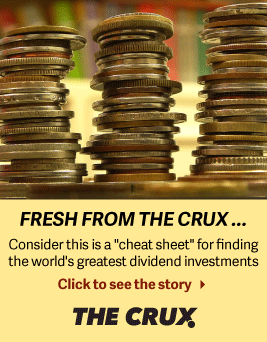| Home | About Us | Resources | Archive | Free Reports | Market Window |
The Best Place in the World to Find Big Dividend YieldsBy
Wednesday, September 3, 2014
Last month, the S&P 500 closed above 2,000 for the first time ever. Stocks are up 75% in just the past three years.
If you've owned stocks for a long time, this is good news. But if you're looking to invest right now and earn income streams on your money, soaring stocks are a problem.
Fortunately, there's an easy solution, which I'll show you in a moment...
When stocks soar, dividend yields decline. Think about it. If a stock trades for $20 per share and pays an annual dividend of $1 per share, its yield is 5%.
But if that stock climbs to $40 per share and pays $1 per share in annual dividends, its yield falls to 2.5%. That's why soaring stocks can be a problem for investors seeking income.
Right now, U.S. stocks yield just 1.8%. It's among the lowest yields in history. That's why dividend-seeking investors should consider going overseas. In many cases, you can get yields that are 100% greater than those offered by U.S. stocks.
The table below displays the dividend yield and price-to-earnings (P/E) ratio of over a dozen major global markets. You can see that countries like Norway, Spain, and Australia are yielding at least 4%... more than double the yield offered by U.S. stocks.
For income investors, this difference is extraordinary. An investment of $20,000 earning a yield of 1.8% produces $360 in annual income. The same investment earning a yield of 4% produces $800 in annual income. While the difference between a 1.8% yield and a 4% yield might seem very small at first glance, when you do the math, you see that $800 is 122% more money than $360. For folks on a budget, this is a huge difference.
Over the past three years, my readers have made a fortune in high-quality dividend-paying U.S. stocks. We're up more than 100% on blue-chip drugmaker Eli Lilly. We're up more than 60% on blue-chip oil company Chevron and blue-chip medical-device maker Medtronic.
We're not selling these winners, but for new money, I'm looking overseas. As you can see, many countries in Europe are sporting high yields. To take advantage, you can buy individual companies in Europe and Australia. You can buy country funds like the iShares Spain (EWP) or the iShares Australia (EWA). Or, you can look around for funds that own baskets of stocks from many different countries.
Whichever way you play it, realize that most of the big dividend opportunities are now outside of the U.S.
Here's to our health, wealth, and a great retirement,
Dr. David Eifrig
Further Reading:
"For many years now," Doc writes, "I've made a bold claim... that retirees could safely earn 12%-20% income streams on their savings. I know it sounds crazy... but my readers have used the strategy behind this claim to close 108 consecutive winning positions." Get all the details here: How to Collect the World's Safest Double-Digit Yields.
Amber Lee Mason reports that in the market, we're often our own "worst enemies." The average investor's annual returns are "way on the losing end, past even inflation." So what can you do to be better than average? Find out here.
Market NotesIT'S A VOLATILE UPTREND, BUT IT'S STILL AN UPTREND Today's chart shows that the trend in emerging markets is volatile... but it's still UP.
DailyWealth highlighted the idea of owning emerging-market stocks many times in the past year. Emerging-market stocks were out of favor... and cheap.
A good way to monitor emerging-market stocks is with the iShares Emerging Market Fund (EEM). It's a giant fund that holds stocks from foreign markets like Russia, China, and Brazil. It's a "one click" way to own a basket of the most important emerging-market stocks.
As you can see from the three-year chart below, emerging markets have been very volatile. Big rallies and big declines are commonplace. But this volatile action has also translated to price gains. Emerging markets are still cheap... and still trending higher.
 |
Recent Articles
|
||||||||||||||||||||||||||||||||||||||||||||||||||||||||||||||||||



